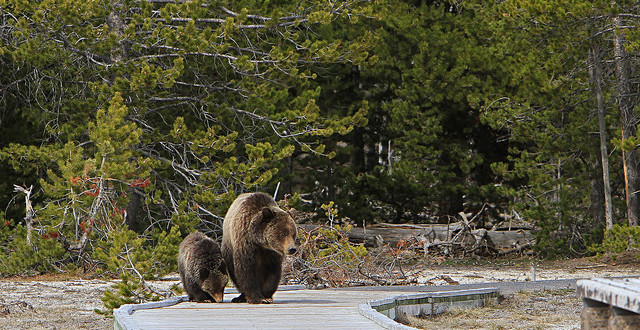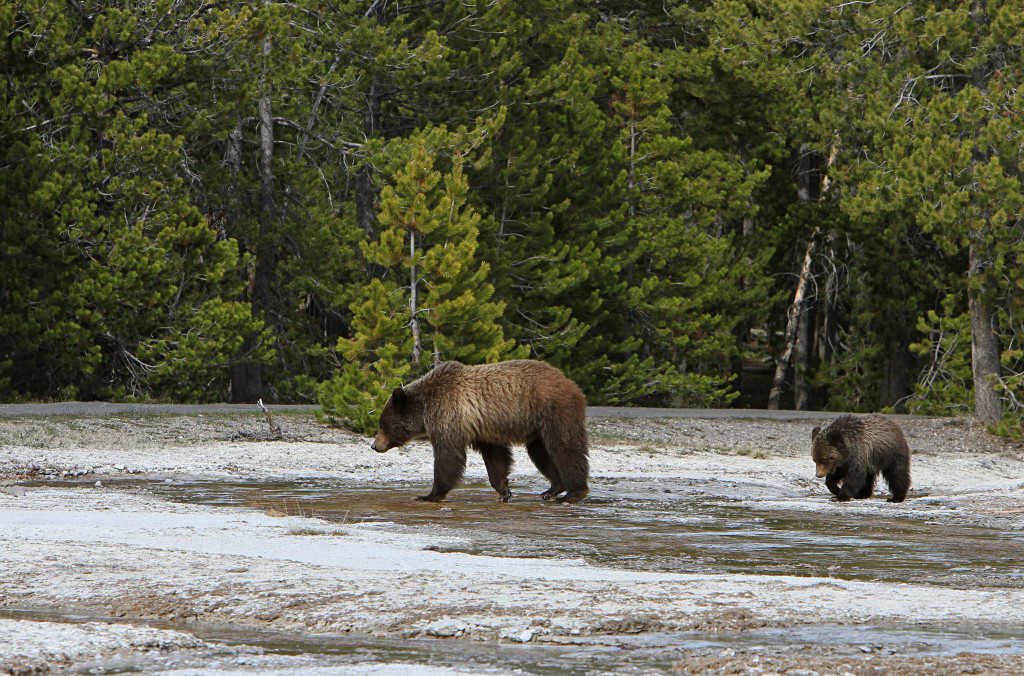Montana Fish, Wildlife and Parks (FWP) officials have released a draft hunting plan for Yellowstone grizzly bears.
The Montana FWP plan would establish spring and fall hunting seasons in seven districts on the periphery of Yellowstone National Park between Interstate 15 and the western border of the Crow Indian Reservation.
Earlier this year, the U.S. Fish and Wildlife Service (USFWS) announced they hoped to delist Yellowstone-area grizzly bears from the Endangered Species List by the end of the year or early next. The agency’s intentions were previously disclosed in a letter from director Dan Ashe to state wildlife managers. Further, we reported that state agencies have already started allocating numbers for possible hunts.
According to FWP spokesman Ron Aasheim, speaking to the Bozeman Daily Chronicle, the state’s proposal was drafted in accordance with the UFFWS’ requirement that state management plans be in place before they pursue delisting procedures. Indeed, the USFWS will include state plans in their final proposal. Wyoming, which would have the largest share of Yellowstone grizzly bears under a potential hunting paradigm, already released their draft plan earlier this year. From the Chronicle:
“This is a first attempt at hopefully a management option that we’re going to have here down the road,” Aasheim said.
The Montana Fish and Wildlife Commission will hear the FWP proposal at its meeting next week and will take an initial vote. If approved, it will then be open for public comment.
Grizzly bears haven’t been hunted in Montana in decades, and have been listed as a threatened species since 1975. The bears were briefly delisted in 2007, but a lawsuit from environmental groups led a federal judge to restore the protections.
USFWS’ new delisting plans include limits on the number of bears that can be killed within a 19,279-square-mile area that covers Yellowstone and parts of all three states. Caps on how many bears can be killed will depend on population estimates within that same area and will be split between the states.
Under a draft agreement — which the commission will also vote on next week — Wyoming would get 58 percent of the total, Montana 34 percent and Idaho 8 percent.
Montana’s draft regulations don’t say what the quotas will be in the different hunting units because they aren’t sure how many bears they might be allowed to take. A memo explaining their proposal said FWP expects Montana’s share to be fewer than 10 and potentially zero in some years.
The Proposed Hunting Season
According to the Chronicle, the fall season would run from November 10 to December 15, while the spring season would run March 15 to April 20. Aasheim said the dates were picked to coincide with the emergence of male bears, which usually emerge prior to females and young bears.
Licenses would be limited based on the bear quota, and hunters who receive a license one year would have to wait seven before being eligible for another go at the license lottery. Further, license holders would be required to attend a course in bear identification—to learn how to differentiate between black and grizzly bears, as well as between male and female grizzly bears.
If approved, grizzly tags would run $50 for resident hunters and $1000 for nonresident hunters; if successful, the hunter (resident and nonresident both) will have to pay $50 for a trophy license.
Proponents and Opponents
Predictably, the announcement drew the approval of hunting groups and outcry from environmental groups and wildlife biologists. From the Chronicle:
Nick Gevock, the conservation director for the pro-delisting Montana Wildlife Federation, said his group likes the draft hunting regulations and he believes they will prevent hunters from taking too many bears.
“I think the agency has put in a lot of safeguards to ensure we don’t have an overharvest,” Gevock said.
On the other side, the Sierra Club’s Bonnie Rice was critical of the proposed regulations. She opposes the hunting of grizzlies and the delisting because she thinks the population is still vulnerable.
Rice noted that 61 bears were killed last year when no hunting took place, and she said beginning hunting when the death numbers are that high is “completely misguided.”
Among the biggest issues with delisting Yellowstone grizzly bears, according to longtime wildlife biologist and former Interagency Grizzly Bear Study Team member David Mattson, is the issue of connectivity: making sure Yellowstone’s grizzly population stays genetically diverse and doesn’t wear out the landscape chasing food sources. Although at least one study posits the Yellowstone grizzly bear population is stable, critics maintain that without addressing connectivity, the Yellowstone population’s genetic diversity (and most likely, every other isolated grizzly population) will only go down—especially if hunting is implemented.
 Yellowstone Insider Your Complete Guide to America's First National Park
Yellowstone Insider Your Complete Guide to America's First National Park







You must be logged in to post a comment.